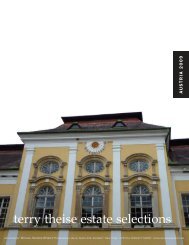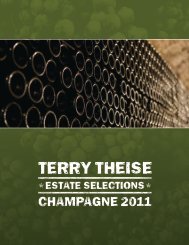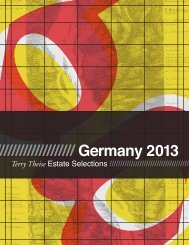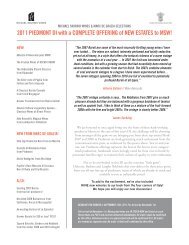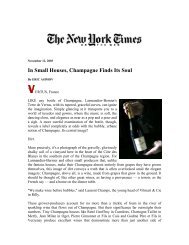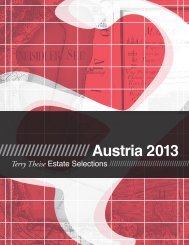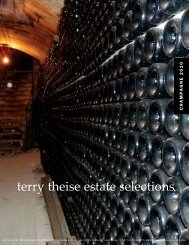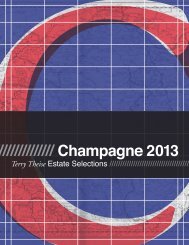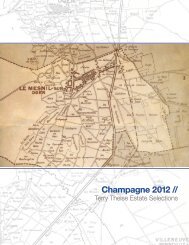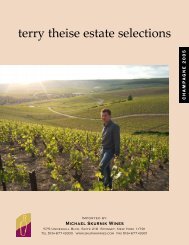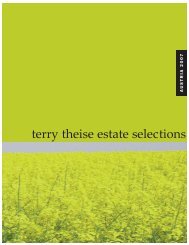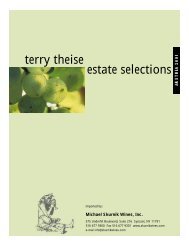German Catalog 2006 USE THIS ONE.qxp - Michael Skurnik Wines
German Catalog 2006 USE THIS ONE.qxp - Michael Skurnik Wines
German Catalog 2006 USE THIS ONE.qxp - Michael Skurnik Wines
You also want an ePaper? Increase the reach of your titles
YUMPU automatically turns print PDFs into web optimized ePapers that Google loves.
the Dhronhofberger Tholey, with its brittle blue clayslate<br />
mixed with qualtz and Klimmer, whose riesling<br />
tastes almost as if it emerged from a tropical garden;<br />
maracuja, papaya, pineapple and with a slight breeze of<br />
honey and caramel. Here on the Mosel we have lovely<br />
variations of slate and exposure.”<br />
And vinification, I ask? Anything which separates<br />
you from the prevailing norm?<br />
“Actually we do nearly nothing differently than did<br />
our forefathers in the 20s: small yields of late-harvested<br />
Riesling grapes are gently handled and pressed (we still<br />
press some in an old wooden press); after an open mustoxidation<br />
the wines fall bright at cool temperatures in stainless<br />
steel, and later ferment in old wooden Fuders. Finito!<br />
That’s all, nothing else, just wait for the wild yeasts to begin<br />
their work. No must or mash sulfuring, no enzymes, no gelatin,<br />
no added vitamins, no bentonite — pure nature!<br />
To the extent we employ technology it is only in the<br />
service of cleanliness.”<br />
I’m curious to know what kinds of wines a grower<br />
drinks at home in private, i.e. what he drinks for pleasure.<br />
Adam says, “A wide range of Grüner Veltliners, which I<br />
prefer to Grand Crus in white Burgundy; Rieslings from<br />
great sites in our region whether dry or sweet; vintage<br />
Champagnes; the occasional rose-scented Muscat from<br />
Südsteiermark or a smoky-flinty Loire Sauvignon from<br />
someone like Dageneau.” Nice to know if I were ever<br />
quarantined at Adam’s there’d be plenty to drink.<br />
He has a telling comment to make about deacidification:<br />
“A great Riesling with a rather high level of acidity<br />
is no catastrophe on the palate; it just needs time. But<br />
if we ever needed to deacidify, we’d have done it before<br />
the grapes ferment, via reduced yields, intensive soil and<br />
leaf work, air-flow management, sun-exposure management,<br />
and finally a selective harvest where we only pick<br />
ripe fruit. I can get aromas from the skins in the presshouse,<br />
and also reduce acids by must-oxidation, which<br />
also eliminates undesirable tannins and phenols.”<br />
Or, one might add, you can take it easy and just<br />
dump in some chemicals.<br />
Finally, as I run through the basics of his vineyard<br />
and cellar work, I need you to understand the extent to<br />
which this is emblematic of the new thinking in qualityminded<br />
<strong>German</strong> vintners, a thinking which has undergone<br />
a 180-degree turn in the last twenty years. These<br />
basics are:<br />
• Exclusively organic fertilizing<br />
• Green-harvest to reduce yields<br />
• Hand-harvesting only<br />
• Must-clarification by gravity (no centrifuges or filters)<br />
• Ambient wild-yeast fermentations (There are<br />
many shades of opinion on this question.)<br />
• Long lees-contact (4 months, followed by another<br />
6 weeks on the fine-lees)<br />
• No dosage (I happen to disagree with this but<br />
applaud the purism which prompts it)<br />
Thus our young hero, and thus my great good fortune<br />
to have encountered him. I look forward to every<br />
glass we will raise together.<br />
He had a practicum at Heymann-Löwenstein, a celebrated<br />
estate in Winningen who was the first to break<br />
free of the whole ripeness-pyramid thing. I gather he’s<br />
worked at Van Volxem too, and Roman wants him back.<br />
“You can’t have him!” I said. “I want him to continue his<br />
winery.”<br />
But the truth is, it isn’t easy. His father was a co-op<br />
member; I think the estate only has five rows more than<br />
a hectare, and if young Mr. Adam wishes to continue, it<br />
will cost many Euro. We are hoping he will, and standing<br />
by to help. All kidding aside, what I actually told<br />
him was “I won’t pressure you, but I will say if you do<br />
decide to continue you will have a highly committed<br />
customer in me.” He’ll probably do a little of each; work<br />
for one of his kindred spirits while growing his own<br />
estate incrementally.<br />
Friend, if you’ve tasted any of the first wave of<br />
Adam wines, you’ll know why I care so much.<br />
With the first taste of the first wine I knew it; here<br />
was someone to be reckoned with. There was simply<br />
more going on here, more weight, more expression,<br />
more seriousness, more drive. How was this estate<br />
under the radar?<br />
As we tasted through his range (7 wines) it was<br />
unequivocally clear to me: This is a star in the making. I<br />
decided to list the wines before I knew their prices!<br />
As I mentioned, Adam’s caught the wave started by<br />
Löwenstein and continued by Roman at Van Volxem.<br />
(Though I think he’s making better wines than both his<br />
“mentors.”) For these growers, the ripeness pyramid of<br />
the <strong>German</strong> wine law is irritatingly irrelevant. They’re<br />
especially annoyed by the whole “Spätlese Trocken”<br />
thing. For them, their dry wines will all be QbA (ostensi-<br />
bly!) and they’ll identify them by site-name, often by<br />
site-names more specific than the law recognizes. You<br />
and I are familiar with this sensibility from Austria, of<br />
course. And it makes sense. <strong>Wines</strong> with significant residual<br />
sugar will be bottled with Prädikat designations,<br />
though most of these guys really don’t like “Kabinett,”<br />
which is inconvenient because, of course, y’all really do.<br />
The <strong>German</strong>s are victims of their own logic here;<br />
Kabinett is positioned as both the driest and most affordable<br />
of the “top” level of production.<br />
But you can always see when a wine law needs<br />
71<br />
MOSEL WINES



